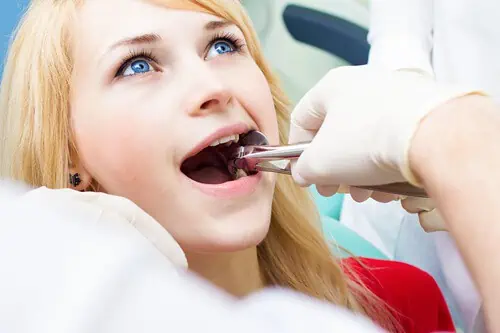Tooth extraction is a common dental procedure that can be done for different reasons, such as severe decay, infection, or orthodontic treatment. After a tooth extraction, proper post-operative care is essential for smooth healing.
Your dentist will give you instructions to speed up the healing process after tooth extraction, and one of those is to not use a straw. So, if you’re an avid iced coffee drinker, you’re probably wondering: When can I use a straw after tooth extraction?
You should wait at least 24 hours after tooth removal to use a straw — but if you can wait a few days, even better.
For wisdom teeth — wait 2 weeks before using a straw.
And always follow the advice of your dental professional first!


Read on to learn about avoiding straws after tooth removal, including:
- Why should you avoid straws after tooth removal?
- Exactly when can you use a straw to drink out of again?
- Just how long do you need to worry about dry socket?
Why can’t I use a straw after tooth extraction?
You can’t use a straw after tooth extraction because you risk dislodging the blood clot on the extraction site. That’s because sucking on a straw creates suction which can cause the blood clot to dislodge. This can be painful and lead to dry socket and infection.
The blood clot is what helps heal the wound. It stops bleeding after tooth extraction, covers the hole where your tooth was before the removal, and protects the bone and nerves that are left exposed after the extraction.
If you think that your blood clot has become dislodged, it’s a good idea to call your dentist. They can then advise you if you need to go into the office for an evaluation.


When can I use a straw after tooth extraction?
You can use a straw 24 hours after tooth extraction, as most dentists recommend this. However, the cells in charge of healing begin to work after the second or third day. In fact, you don’t want to do anything that causes a sucking motion, such as spitting or smoking.
By avoiding the sucking motion, you can prevent dry socket and avoid a whole lot of pain. Additionally, your age and medical history affect the healing process, so your dentist may have different instructions.
Here is the process of normal healing for a healthy person after a simple tooth extraction:
- Blood clots are required for normal healing. Clotting occurs naturally after the tooth is extracted, and blood fills the empty socket.
- The presence of a blood clot allows for the subsequent stages of healing, which include the accumulation of white blood cells as well as the release and formation of enzymes to produce the collagen and granulation tissue required to begin healing the wound.
- Normal oral healing is similar to skin healing, but it occurs faster.
- Since normal healing occurs in stages, it can take up to 3-4 weeks before bone formation and soft tissue growth, also known as epithelialization of the mucosa, is complete and the socket appears closed.
When can I stop worrying about dry socket after tooth removal?
You can stop worrying about dry socket a few days after your tooth removal. Dry socket is the most common complication patients experience after having teeth extracted; it means that bone was exposed because of an absent blood clot and can be quite painful.
Dry socket typically occurs 1-4 days after extraction and is caused by the disruption or dislodging of the blood clot that forms naturally after an extraction. The bone can be completely exposed or covered with grayish tissue. There is pain that does not respond to medication, and there may be swelling and a malodor.
Even if you don’t use a straw or forcibly spit for several days, some patients may still experience dry socket due to pre-existing medical conditions such as diabetes, contraception, chemotherapy, and so on.
The treatment consists of several days of saline or chlorhexidine irrigations, a dressing applied by the dentist, and/or antibiotics prescribed if necessary. The good news is that you can help prevent dry socket if you avoid certain activities. These include smoking, harsh rinsing, drinking hot beverages, and using straws.
Here is a video about dry socket:
Once your mouth has completely healed, you can stop worrying about the dreaded dry socket. Check out our full dry socket guide for more information!
Conclusion


By now, you’ve discovered that you shouldn’t drink from straws for at least the first 24 hours following your dental surgery, but it’s even better to wait a few days.
After your oral surgery, it’s important to follow the directions your dentist gives you so that you can make sure you have a safe and speedy recovery. Your dentist will instruct you to avoid drinking from straws and other activities that involve a suction motion, like smoking cigarettes or forceful rinsing.
The first step to properly healing is forming a blood clot over the extraction site. Everything you do for the next week or a couple of weeks will be focused on maintaining that clot so that it does not become dislodged. This is important because the clot protects your bone and nerves after oral surgery.
If you’re unsure of what advice would apply in your situation or have any questions about your tooth extraction recovery, you can chat with a dentist online. Chatting with a dentist 24/7 can help you get answers to your questions on tooth extraction recovery, especially if you need help fast.
So, to summarize—
- Wait at least 24 hours to use a straw (preferably more)
- Avoid extremely hot or cold liquids
- Don’t smoke or rinse harshly
- Avoid drinking alcohol while you heal
- Contact your dentist if you think you’ve dislodged your blood clot
- Follow your dentist’s instructions for after tooth extraction
—and then you should be well on your way to healing in no time!


Can I use a straw 3 days after tooth extraction?
You can use a straw 3 days after tooth extraction as long as the extraction site is fully healed and your dentist says it’s ok. But of course, the longer you can wait, the better!
Can I use a straw 7 days after tooth extraction?
Yes, you can use a straw 7 days after tooth extraction if you are certain that everything is all healed up. At this point, you should still double-check with your dentist, just in case. And if you’ve had your wisdom teeth pulled, then you should wait another week.
Can I use a straw 10 days after tooth extraction?
Yes, you can use a straw 10 days after tooth extraction (again, follow your dentist’s instructions). If your mouth isn’t healed 10 days after a regular tooth extraction, you should contact your dentist. Wisdom teeth take longer to heal, and dentists generally recommend that you wait 2 weeks to drink from a straw.
When can I use a straw after wisdom teeth removal?
You can use a straw 2 weeks after wisdom teeth removal. However, you must follow your dentist’s instructions so as not to cause problems with the healing process.
Once a blood clot has formed, can I use a straw?
Once a blood clot has formed over the site in your mouth, that’s a good sign that you are on your way to healing after your tooth extraction, but you need to keep it intact. The best way to ensure that is to follow the instructions from your dentist following surgery and take proper care of the site. This means you should avoid things like drinking through a straw before the time recommended by your dentist has passed—even if the blood clot has already formed.




